covid-19 climate and bird-flu-strength-pandemic clarion call
Physical Distancing Win-Win: Not only has the better-late-and-emphatic-than-late-and-half-hearted shelter-in-place stopped the exponential spread of covid-19, it has slashed the shameful incidence of seasonal influenza, freeing up New Zealand’s hospitals to better-cope with pandemic patients. The first learning from this crisis needs be that seasonal influenza—the 400-person-a-year-killer—must be eliminated within Aotearoa—tracked and traced with the same, newfound determination. graph Department of Health Australia | Ministry of Health Aotearoa | labels Mahurangi Magazine
Spain, officially, has had not quite 0.5% of its population infected by covid-19, about a third of the rate the maligned country experienced during the 1918 Pandemic. But 10% of those undeserving more than 230 000 people have died, and its economy is in its worst situation since the 1936–39 Spanish Civil War.
That a similar number of Germans have been infected with fewer-than-1% dying is due mostly, presumably, to their health system with its more than twice the availability of intensive-care-unit beds, coping much better with their less than half the rate of infections. Globally, most populations will experience impacts closer to Spain’s, the United Kingdom’s and the United States’, than Germany’s. If the wicked World Health Organisation-worst-case projection for Africa is applied to the world’s most vulnerable 6 billion, nearly 15 million will die. But the fatality-rate range experienced by Spain and Germany—maybe 10% to 0.5%—is 5 to 53 times lower than the human mortality resulting from h5n1 bird flu, that has killed 452 of the 856 people known to have been infected by it. In Asia 2004–2005, more than 100 million chickens were culled to contain h5n1, and in a Thailand zoo, 80 tigers.
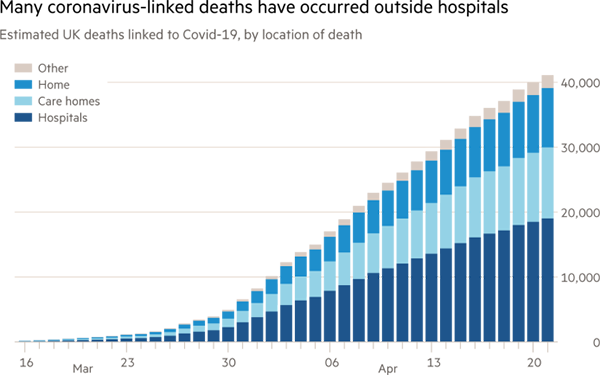
More-Than-Doubly-Deadly, First Wave: As in all disasters, the early reported deaths belied the full unfolding toll of the epically contagious covid-19—and as least as deadly as the disease of the 1918 Pandemic. Without near-miraculous progress with the development, trialing, production, and administration of a highly effective vaccine, a second more-deadly wave of the pandemic is likely hit the northern hemisphere during its next, deadly, flu season. graph Financial Times
With heroic evidence-based responses, from here on in, the global infection rate may plausibly be kept within single percentage points, and deaths, likewise, of that rate. However, if the responses of the world’s two most recent leading superpowers, the United Kingdom and the United States, are any indication, covid-19 will demonstrate, over the next several years, how disastrously dysfunctional, intergovernmentally, the world is. What remains to play out is whether the needless human and economic cost of this crisis will result in radical reform of the intergovernmental structures that are conspicuously failing to address the wicked problem of anthropogenic global heating.
Protest has been orchestrated In Aotearoa, and less politely in the United States and Brazil, at the continued, state-enforced, physical distancing. covid-19 containment versus the economy is a false dichotomy, shamelessly financed by the usual suspects. Similarly, however, the choice to re-stimulate the existing problematic economy or to build one with a robust future, is false. In times of crisis, there is reticence to be perceived as unseemly by advocating for overarching actions. But now is exactly the time to examine every aspect of New Zealand’s, and the intergovernmental, pandemic response. Aotearoa, for example, could have been much more useful to the world had it closed its border and implemented strict quarantine measures by late January. A fortnight’s shelter-in-place for the non-essential majority, and the rigorous testing urged by the World Health Organisation at the time, would have provided every opportunity to avoid prolonged period of enforced unemployment that will, for all too many, effectively prove to be permanent. By putting its own mask on first, Cuba is demonstrating how a country can better help the more vulnerable.
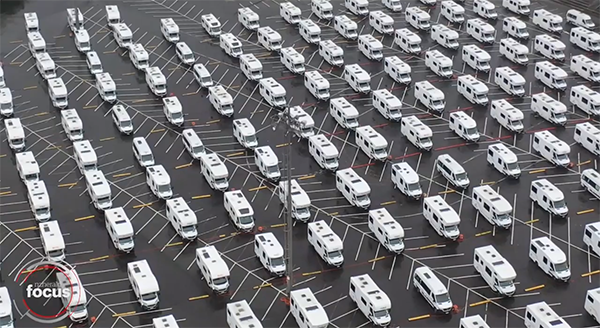
covid-19 Campground: Although the polar-opposite of a zero-carbon visitor model, campervans are at least currently providing essential quarantine accommodation that, if deployed by late January, in conjunction with testing and tracing could have allowed Aotearoa to function with only the physical distancing protocols long since necessary to mitigate the avoidable, deadly epidemics of seasonal influenza—when pandemic coincides with seasonal epidemic, the results are way worse than double-whammy. image Peter Meecham | New Zealand Herald
New Zealand’s visitor industry will never be the same, but nor should it be. Aotearoa must play to its strength as the epitome of physical distancing—renowned as the place where the mandatory minimum length of stay is six weeks, such is the seriousness with which the country takes the need to radically slash carbon emissions. And rather than profoundly problematic cruise ships wallowing into New Zealand waters, a small fleet of high-speed latter-day packet-liners plying to and from Sydney, connected to Australia’s 36 000-kilometre-long rail network, and, into the bargain, to the more than half-million New Zealanders living there.
After its serial earthquake crisis, Christchurch was rebuilt, and ChristChurch Cathedral is rebuilding, on liquefaction-prone land within inevitable reach of locked-in sea-level rise, rather than risk an unseemly debate about a sustainable alternative location inland of its airport. But nor would any usable buildings have needed to have been summarily abandoned, had the opportunity been embraced to progressively retire the extensively damaged city as an antipodean Angkor Wat. Even before covid-19 struck, civilisation had its time cut out to build zero-carbon infrastructure sufficiently quickly. Signs of sustainable transport for suburbia are sparse, and, again, even pre-covid-19, a stalled Labour-led government had ditched any fealty to a zero-carbon future by ordering the resumption of roading work it had earlier side-lined.
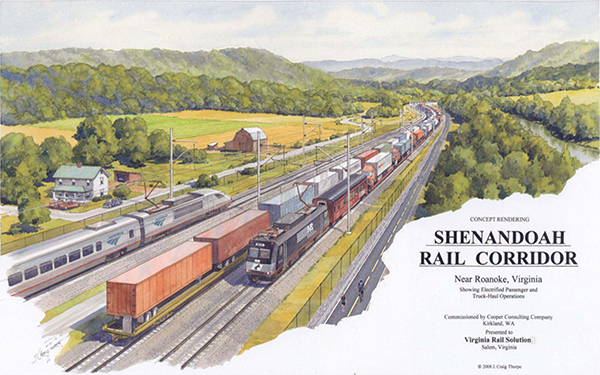
Rendering Road Transport Largely Redundant: Grid-powered transport alongside trail doesn’t depend upon defying the laws of thermodynamics to deliver the zero-carbon infrastructure needed for a post-covid-19 visitor industry. concept rendering Craig Thorpe
The reason more motorway is to be built, post haste, is because the projects are shovel ready. Few actual shovels, of course, would be swung, whereas oceans of diesel fuel and shiploads of heavy machinery are to be deployed, by mere thousands of workers, whose spending would need to trickle down to the up-to-half-million who now may end up out of work. That more than 70% of the average $5.1 billion per year draft 2021–2031 land-transport budget is earmarked for roads reflects a transport agency marching backwards into the future. Small wonder, when the government sought to give the election-year economy a boost, the shovel-ready projects were predominantly more roads, and that trail building was not ready to be actioned. This private-transport legacy of New Zealand’s unfortunate, failed neoliberal experiment needs to be parked up, and the spending redirected to directly employ New Zealanders to begin building a sustainable future. Given the unemployment crisis, the first obvious step is to redeploy the emptied lecture halls, to serve, mostly remotely, students of campaign finance reform, coastal resilience, communicable and noncommunicable disease, digital infrastructure, exotic and indigenous forestry, grid-powered transportation, trail design and engineering, science-based journalism, sustainable visitor infrastructure, zero-carbon energy production, xenophobia and pandemics, and much more.

Importance of Face-to-Face: There has long been an noncommunicable diseases, not to mention climate, need to decentralise workspaces, to within walking distances of residences. Now, with the pandemic-mandated-imperative to physical distance added to that of seasonal influenza, meeting spaces must be reimagined and used much more judiciously, and, of course, with some means of intercepting spittle. image Transport and Marine Covers
It is not by accident that any suggestion of centralised planning is promptly denounced, and with statements that it is foolish to attempt to anticipate the future. Aside from the distinction that planning for the future is not the same as predicting it, planning is attacked because of its potential to impose on the power of the plutocracy. In his seminal Transport for Suburbia: Beyond the Automobile Age, Dr Paul Mees identifies planning as one of the key characteristics of successful public transport. Conversely, covid-19 has catapulted the need to not travel unnecessarily into sharp relief. Had New Zealand’s businesses’ and institutions’ embrace of distance-working been much less grudging, the country could have responded to the imperative for physical distancing with alacrity. Given the likely need to maintain a degree of physical distancing through 2022, comprehensively connecting Aotearoa with fibre—something the market has conspicuously failed to deliver—should be pursued with vigour. A recurring failure of New Zealand-based startups has been their need to relocate to Northern California on account of poor cellular coverage and bandwidth bottlenecks, whereas wealthy Californians rush to buy boltholes in Aotearoa. But not only do the tech startups struggle internationally, they struggle to better-connect New Zealanders to things:
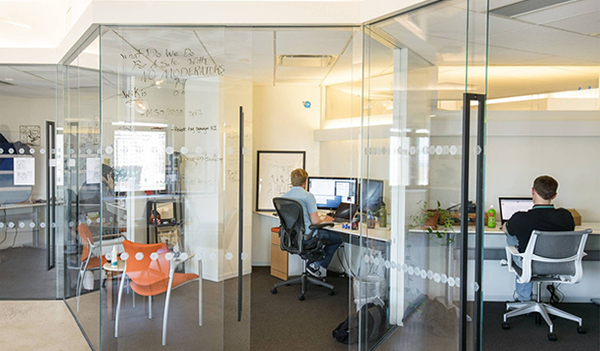
Blessed Are the Doormakers: With open-plan office space long since the norm, and working from home, for some, sustainable in small doses, and a future where the need for a degree of physical distancing is likely to endure—not least of all to address the seasonal influenza toll—is also likely to be a future involving more doors. image Stack Overflow
Journey avoidance, the poor cousin of zero-carbon initiatives, will presumably now receive some much-deserved, covid-19 due:
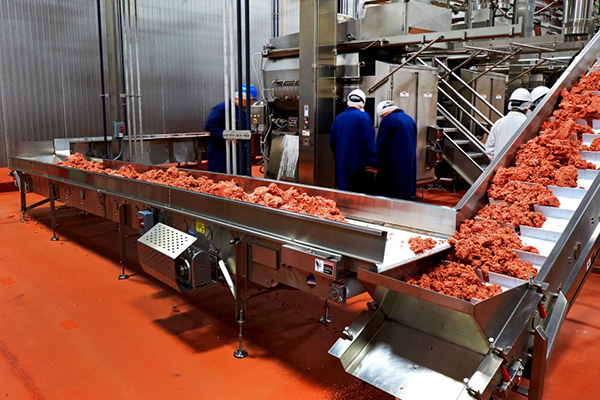
Appetite for Post-covid-19 Change: Receiving us$500 million in its f-funding round just as the wet-market-associated pandemic hit, Impossible Foods, and meatless-meat enterprises like it, will surely be assured of stela growth, atop their low-carbon appeal, and the potential to end the caging of chickens, and other grotesque meat-production practices. image Impossible Foods
Avoiding journeys and/or reducing travel distances can be achieved in many ways. Proximity planning, for instance, aims to minimize travel distances through smart urban planning in which cities are designed to be compact, with complementary goods and services located near each other. Proximity planning is illustrated by a study from Santiago, Chile, where researchers estimated that relocating schools closer to residential areas could reduce transport emissions in the study area by 12%.
That Aotearoa has so far escaped covid-19 with a reported infection rate of 0.03%, and a reported fatality rate of 1.23% of that, is down to geography, timing in relation to its seasonal influenza season, and not taking quite as long after hitting double digits as, for example, Ireland, to mandate emphatic physical distancing—Aotearoa, 12 days, by which time there were 394 reported cases; Ireland 21 days, 1819 cases. As of anzac Day, Ireland, with an almost identically sized population, has a more than 12 times greater number of reported cases, and 59 times the number of reported deaths, nearly half of those in care homes, and likely eventually to eclipse the 4000 Irish troops killed at Gallipoli.
In just four months, a virus with a mortality rate a fraction of that of h5n1 bird flu, infecting fewer than 1% of people, is comprehensively overwhelming most of the world’s health systems. With Rooseveltian leadership, Aotearoa could heed the covid-19 clarion call, and demonstrate dynamic, world-inspiring business and social economic mobilisation.
Achilles’ Heel of current strategies The following are the two concluding paragraphs of Asymptomatic Transmission, the Achilles’ Heel of Current Strategies to Control Covid-19, published 28 May 2020:
Ultimately, the rapid spread of Covid-19 across the United States and the globe, the clear evidence of SARS-CoV-2 transmission from asymptomatic personsArons MM, Hatfield KM, Reddy SC, et al. Presymptomatic SARS-CoV-2 infections and transmission in a skilled nursing facility. N Engl J Med. DOI: 10.1056/NEJMoa2008457, and the eventual need to relax current social distancing practices argue for broadened SARS-CoV-2 testing to include asymptomatic persons in prioritized settings. These factors also support the case for the general public to use face masks when in crowded outdoor or indoor spaces. This unprecedented pandemic calls for unprecedented measures to achieve its ultimate defeat.

Becoming Wise Before the Event: Despite now experiencing 17 pandemics—and 6 of those since 2002—the world was found to be pitifully ill-prepared for when, with predictable unpredictability, this current pandemic manifested. Preparing for the potentially far-deadlier effects of anthropogenic global heating, as well as being an inescapable existential imperative, can, simultaneously, better equip humanity to respond to epidemics, and prevent more becoming pandemics. Here, the initially all-but-imperceptible case-infection rates displayed for India and Indonesia were grave indicators of governments in desperate denial of their countries’ now-destined roles in the raging pandemic—and early exemplar Singapore demonstrates the ruinous consequences of neglecting its most vulnerable workers. Nigeria, however, scams all 207 million of its citizens, by testing fewer than 1% of them, thus hiding the appalling impact of the pandemic there. Australia long-since lost her battle to keep within cooee of covid-19-test-kit-exporter extraordinaire South Korea’s standout response. Aotearoa, meantime, has flat-lined in a good way. All countries’ infection rates are under-reported, some because a few cases, particularly early in the pandemic, are misdiagnosed, but in other countries monstrously, due to dysfunction and/or lack of transparency. The diameter of each line on this graph is proportional to the country’s population. graph Mahurangi Magazine | data Our World in Data 12 November 2020
Join FluTracking now and help prevent future pandemics…
Salutary Lesson in Seasonal Influenza: Physical distancing has also paid dividends in reducing the annual toll extracted by flu that, despite its deadliness, is treated as an inconvenience rather than the killer it is, particularly of the very young, the elderly, and the pregnant—“On average, approximately 400 deaths are attributed to influenza and its complications annually.” covid-19 provided the opportunity to begin collecting flu-symptom data earlier than was done 2018–2019. graph Department of Health Australia | Ministry of Health Aotearoa | labels Mahurangi Magazine
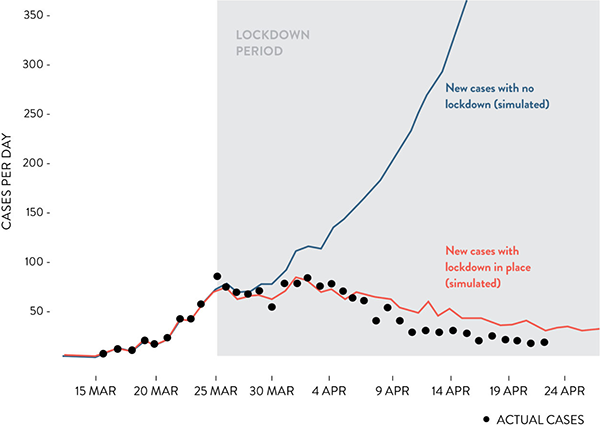
New Zealand’s Altered Future: Moving nine days faster than Ireland, and more emphatically physically distancing, Aotearoa has avoided Ireland’s near vertical trajectory—until the middle of May—of reported covid-19 cases. Ireland’s prime minister then donning his sweats was perhaps great optics, but responding to, for example, fellow general practitioner Dr Marcus de Brun, or to nursing-home representatives more than seven weeks earlier, would have constituted a far more heroic course of action. Aotearoa, for its own survival, now needs to convince the world to alter its determinedly fossil-fuelled future. chart New Zealand Geographic | Te Pūnaha Matatini

Will we ever learn!
An observation about the irony of the ChCh CBD rebuild – locals have not returned to the new CBD. During the long rebuild the population adjusted to life around local community centres. The only people to be seen in the CBD are tourists! And now, thanks to Covid 19, there are no tourists.